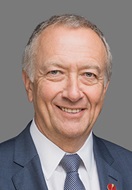- Hear!
- Rabble!
- Read Aloud
My name is Rosa Galvez, I am a senator from Quebec, and I am the chair of the committee.
Today, we are holding a meeting of the Standing Senate Committee on Energy, the Environment and Natural Resources.
I’d like to start with a very important reminder. Before asking and answering questions, I would ask members and witnesses in the room to refrain from leaning in too close to the microphone or removing their earpieces when doing so. This will avoid any sound feedback that could negatively impact the committee staff in the room.
[English]
I will ask my fellow committee members to introduce themselves.
[Translation]
- Hear!
- Rabble!
- Hear!
- Rabble!
- Hear!
- Rabble!
- Hear!
- Rabble!
- Hear!
- Rabble!
- Hear!
- Rabble!
- Hear!
- Rabble!
- Read Aloud
Thank you colleagues. I wish to welcome all of you and the viewers across the country who are watching our proceedings. Today, the committee has invited government officials to appear as part of its examination of Bill S-14, An Act to amend the Canada National Parks Act, the Canada National Marine Conservation Areas Act, the Rouge National Urban Park Act and the National Parks of Canada Fishing Regulations.
We welcome, this morning, from Parks Canada, Jewel Cunningham, Vice-President, Strategic Policy and Planning and Andrew Campbell, Senior Vice-President, Operations. Welcome and thank you for accepting our invitation.
Ms. Cunningham will have the floor for five minutes.
- Hear!
- Rabble!

- Read Aloud
Thank you very much.
Honourable senators, thank you for the invitation to discuss Bill S-14. With me here today is Andrew Campbell, Senior Vice-President, Operations.
I would like to start by recognizing that we are meeting today on the unceded and traditional territory of the Algonquin Anishinaabe people.
As you know, the Government of Canada introduced Bill S-14 in the Senate on October 19, 2023.
[Translation]
The bill before you proposes amendments that would see more than 12 million hectares formally protected under the Canada National Parks Act and the Canada National Marine Conservation Areas Act.
The Canada National Parks Act and the Canada National Marine Conservation Areas Act will be amended to finalize the establishment of Akami-UapishkU-KakKasuak-Mealy Mountains National Park Reserve and the establishment of Tallurutiup Imanga National Marine Conservation Area, once the interim management plan is complete.
Additionally, the Canada National Parks Act will be amended to formally update the boundaries of seven existing national parks and one national park reserve.
[English]
While these lands are already managed or under the administration of Parks Canada, this legislation will ensure that they receive the full protections of the Canada National Parks Act, the Canada National Marine Conservation Areas Act and associated regulations. This is the final critical step to ensuring that these lands are protected for current and future generations.
The legislation also includes six housekeeping amendments that will align the Canada National Parks Act and the Rouge National Urban Park Act with the modern legislative environment and strengthen the tools used to operate and manage Parks Canada’s network of protected areas.
Honourable senators, Parks Canada administered places are a source of shared pride for all Canadians. They are also world renowned as places of shared stewardship with over 300 First Nations, Metis and Inuit peoples.
National historic sites, national parks, and national marine conservation areas represent the very best that Canada has to offer and tell stories of who we are, including the histories, cultures, and contributions of Indigenous peoples. As I have already intimated Parks Canada does not do this important work alone.
In particular, since the Constitution Act of 1982, the creation and expansion of national parks, reserves, and marine conservation areas in Canada involves extensive consultation and collaboration with a variety of partners and stakeholders, including provincial, territorial, and Indigenous governments, groups, and communities.
It’s important to acknowledge that it was not always this way.
In many past instances, when the Government of Canada designated heritage places, lands were expropriated from settlers to Canada and Indigenous peoples were separated, often forcibly, from their ancestral lands and waters. Connections were severed by policies that resulted in intergenerational harm through loss of Indigenous knowledge, cultures and identities. Many heritage places administered by Parks Canada have seen a transition over time to our current context. Today, lands are acquired from willing sellers, donated or transferred from another level of government or from another federal department. Most importantly, Parks Canada strives to work collaboratively with Indigenous peoples in this regard, often creating formal agreements to acknowledge rights and recognition of land.
As mentioned early in my remarks, Parks Canada is currently engaged with more than 300 First Nations, Inuit and Métis communities across this country, collaborating in the conservation, restoration and presentation of natural and cultural heritage. Let me be clear that the lands included in Bill S-14 would not be before you today to include in permanent protection without extensive consultation and negotiation with Indigenous governments and communities, provincial and territorial governments, and local communities, including regional stakeholders.
For example, in the case of Akami-Uapishku-KakKasuak-Mealy Mountains National Park Reserve, there are several agreements with Indigenous governments and organizations, and the province clearly stating that Parks Canada is committed to establishing this site as a national park reserve. This includes agreements with the Labrador Innu, the NunatuKavut Community Council and the Government of Newfoundland and Labrador. These agreements were the result of lengthy discussions, negotiations and consultations.
Taking years of consultation, negotiation and relationship building, the final step for a protected area is when it is written into legislation. With the tabling of Bill S-14, Akami-Uapishku-KakKasuak-Mealy Mountains National Park Reserve and Tallurutiup Imanga National Marine Conservation Area have reached this final step of the process, and Indigenous communities have asked for additional measures to be added to bring these areas into force.
As one might imagine, each project will have its own unique set of circumstances to be considered and different partners and stakeholders to be consulted. The expansion of Tuktut Nogait National Park included in the bill is a good example. The park covers more than 16,000 square kilometres in the northeastern part of the Northwest Territories, within the Inuvialuit Settlement Region, as defined by the Inuvialuit Final Agreement land claim. The park was first proposed by the community of Paulatuk in 1988, as a way to protect the calving grounds of the Bluenose-West caribou herd. In fact, the name Tuktut Nogait means “young caribou” in Inuvialuktun. Bill S-14 would increase the park area by some 11 percent, adding another 1,800 or so square kilometres and expand the park into the Sahtu Settlement Area.
Under the Sahtu Dene and Métis Comprehensive Land Claim Agreement, Canada committed to consult the Sahtu Dene and Métis on any national park proposal within their settlement area. In 2000, Sahtu Secretariat Incorporated formally requested that the federal government initiate negotiations to establish the Sahtu portion of the park. The consultation process, with respect to section 35 obligations that followed, included meetings with elders, and door-to-door interviews with community members from Paulatuk, Délı̨nę, and Colville Lake. It also included direct communication with the Délı̨nę First Nation, Ayoni Keh Land Corporation and the Sahtu Secretariat Incorporated.
In addition, in 2022, a preliminary screening for the proposed addition to the national park was done as required by the Mackenzie Valley Resource Management Act. The screening documents were shared with over 40 parties, none of which expressed any concerns about the proposed expansion of the park.
I would note that the park is managed by the Tuktut Nogait Management Board, which comprises members appointed by or on the advice of the Inuvialuit Regional Corporation, the Inuvialuit Game Council, the Paulatuk Community Corporation, the Paulatuk Hunters and Trappers Committee, the Délı̨nę Got’įnę Government, and the governments of the Northwest Territories and Canada.
A similar approach to consulting Indigenous communities and other stakeholders, including tourism operators and the public, was done for all of the protected areas affected by this bill. In the case of Indigenous communities specifically, all have either stated their support for the inclusion of lands in the Canada National Parks Act or the Canada National Marine Conservation Areas Act, and none have put forward objections. Provincial and territorial governments affected by the proposals in the bill are supportive, as are other stakeholders.
Honourable Senators, Parks Canada has done the work to garner Indigenous, provincial, territorial and public support for this bill. I would respectfully recommend that the Senate support this bill. Thank you.
- Hear!
- Rabble!
- Read Aloud
Thank you very much. We’re going to go to questions, so we’ll start with Senator Miville-Dechêne.
- Hear!
- Rabble!
- Read Aloud
Welcome to you both. For several years now, the Mingan Archipelago has been suffering more and more from the harmful effects of climate change, such as a drastic drop in the number of birds, seals, mackerel and herring, and of course, shoreline erosion. Now, in this case, I understand that you’re removing three islands from the park’s perimeter, including Île de la Maison, while expanding the park by 42 hectares.
Why are you doing this? What exactly are you doing in this park to combat climate change? I’m very attached to this park, where I used to kayak. I was able to see the wonders of the Mingan Islands.
- Hear!
- Rabble!

- Read Aloud
Thank you very much, Madam Senator. That’s an excellent question. The three islands we obtained as part of the park’s expansion were part of the Innu’s request, and they were obtained through an agreement with the former owners of these islands.
[English]
- Hear!
- Rabble!
- Read Aloud
You are not eliminating, but you are adding those islands.
- Hear!
- Rabble!

- Read Aloud
Yes, that is what is being added within the bill. The change of boundaries actually adds places within the Mingan Archipelago. Île du Havre is added, as well as a couple of other small islands within Mingan. That is the inclusion that we are proposing within the bill.
- Hear!
- Rabble!
- Read Aloud
I didn’t understand that while you didn’t suppress any islands, you are in this case extending it. That’s great news.
[Translation]
- Hear!
- Rabble!

- Read Aloud
It was totally thanks to the support of the Mingan Innu groups, too.
- Hear!
- Rabble!
- Read Aloud
Here is my other question: what are you doing to combat climate change in this particularly fragile place?
- Hear!
- Rabble!

- Read Aloud
There are several different stages that we’re in the process of setting up over there. In some islands, we have projects that are called ecological restoration; in some islands, there are projects to return certain places to a natural state — in three or four islands.
With the assets and workforce that are there, it’s necessary to fight climate change with —
[English]
— hardening of the assets there, so they are not blown away by larger storms.
We are taking steps to be able to have, for instance —
[Translation]
The docks there are now better fortified; this is an example.
There are a number of steps to make sure there’s more monitoring there with regard to climate change.
- Hear!
- Rabble!
- Read Aloud
I have one last question.
To protect their national parks, the United States has started limiting the number of people who can come there each day, and imposing quotas. Here in Canada, are we there yet?
[English]
- Hear!
- Rabble!







